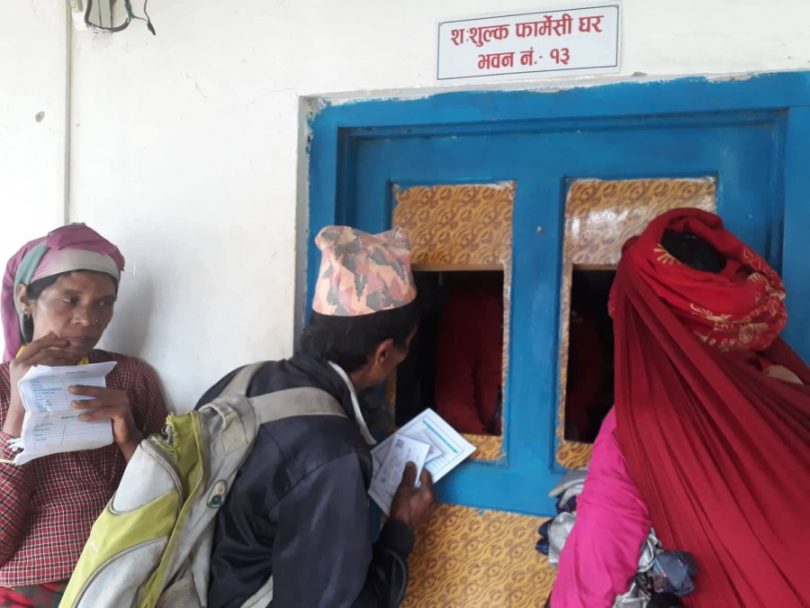[ad_1]
Article 35 of the Constitution of Nepal guarantees the right of citizens to free basic health services from the state. However, in practice, health care is one of the most commercialised sectors in Nepal. There are abundant private hospitals with opulent facilities in Kathmandu and other urban areas, but healthcare facilities are still rudimentary in rural regions. According to a 2021 data from the Ministry of Health and Population, there were 110 hospitals, 10 health centres, 3,789 health posts and 3,176 sub-health posts in Nepal. The frequency of physicians is one per 18,400 people. Nepal is among the countries with the lowest global health care index—ranking 107th globally, and 6th among eight South Asian countries. The main reason for this is the inefficiently implemented health care policy over the years. Apart from that, the unbearable cost of medical services in private and inadequate facilities in government hospitals are also the reasons that are alienating the citizens from the constitutionally guaranteed right to basic health care services.


The manifestos of all major political parties include the implementation of ubiquitous access to health care services once they form the government. Unfortunately, the promises are broken once the respective parties command the power to operate state machinery. Since the promulgation of the new constitution in 2015, minimal progress has been achieved in this sector; no sustainable policy has been drafted, and no effective homework has been done to materialise the mandatory constitutional directive.
The foremost requirement for ubiquitous access to health care is its cost-effectiveness. If the service is too costly, as it is at the moment, a large section of the people is deprived of fundamental rights. On the contrary, the cost of health service commodities, including medicines and hospital equipment, is skyrocketing globally. Within the present health care setup, it is impossible for the government to provide even the basic medical services to the people free of cost or with nominal charges. So the government needs to overhaul its existing health care strategy.
To overcome this obstacle, the statutory health insurance system will be the perfect solution for Nepal. The best example of this practice is Germany, where the health insurance system has been in practice since 1883. It is the world’s oldest national social health insurance system, rooted in the defining principles of solidarity and self-governance. These principles have remained at the core of the country’s continuous development for over 140 years. About 90 percent of Germans are insured through statutory health insurance and the rest 10 percent have private insurance.
In Germany, health insurance is mandatory for everyone; even temporary visitors require valid health insurance for the period of their stay. Within the country, the employer pays a share of the costs for the employees’ statutory health insurance, amounting to 14.6 percent of gross salary. This is a separate employer contribution, and the amount is not deducted from the employee’s salary. If only one member of the family is employed, their health insurance is valid for the whole family—spouse and any number of children. The same applies to pensioners. The government takes care of the complete health insurance formalities of jobless citizens and refugees. On the recommendation of a certified physician and health care professional, the health insurance company covers the costs of available medical facilities and required medicines. Due to this state-of-the-art health insurance system, no one is deprived of necessary medical services in Germany. Hence, the life expectancy of Germans is one of the highest in the world.
In contrast, little progress has been made on the health insurance system, and lawmakers seem to be muddled in grabbing power at any cost. Politicians and people with high-level contacts are never deprived of necessary health care services. A privileged group of people travels abroad for the slightest of health problems and subsequent follow-ups. An investigative report published recently in Kantipur reveals that an average of about Rs18 billion per year was spent on providing medical facilities to high-level politicians and other present and retired officials over the last seven years. This accounts for almost 1 percent of Nepal’s annual budget for fiscal 2022-23. Had this money been invested in upgrading the services of existing hospitals and health care facilities, the public would have also immensely benefitted.
The main priority of the recently formed new government should be acting towards fulfilling the constitutional directive of the right of every citizen to free basic health services. For that, the German model of the statutory health insurance system can be adopted in Nepal. Firstly, a health insurance board should be formed to plan a sustainable statutory health insurance policy. A certain amount of the income of every citizen should be directly deposited in an insurance fund. The government should compensate the amount for unemployed and underprivileged citizens. The medical costs of the citizens should be paid to the respective hospitals and healthcare facilities directly from the insurance fund. This will reduce the mammoth burden of the citizens to self-finance their medical costs.
Undoubtedly, if properly executed, the health insurance system will be a big success in Nepal. The successful implementation of a similar small-scale pilot project in Amppipal hospital in Gorkha strengthens this. A German non-government organisation, Nepalmed Foundation, currently manages the former mission hospital. In 2017, Gorkha was selected for the implementation of a trial model of health insurance, Amppipal hospital being the central service provider of this scheme. The insurance costs Rs2,500 per year for a family of five and Rs425 for each additional family member. The basic health care service and emergency facilities costing up to Rs300,000 per year are included in the package (bone implantation, spectacles and private rooms are excluded). Patients are required to pay the treatment costs beyond this limit themselves. Since its implementation, the project has flourished, and about 85 percent of outpatient department patients are insured now. This has lessened the encumbrance of the people in that region to self-finance their medical costs. A similar model could be adopted on a larger scale by the government and should be gradually transformed into a statutory health insurance system.
During a long period of political instability, the governments were not able to focus on establishing a sustainable health insurance system in Nepal. This is high time for the government to act unconditionally in this aspect. Taking inspiration from the pioneer in the health insurance system, Germany, and enunciating the outcomes of the health insurance concept at Amppipal hospital, the government should establish a health insurance board and adopt the statutory health insurance concept. This will put Nepal in a different league of global health care systems, a big step forward for the country.
[ad_2]
Source link








